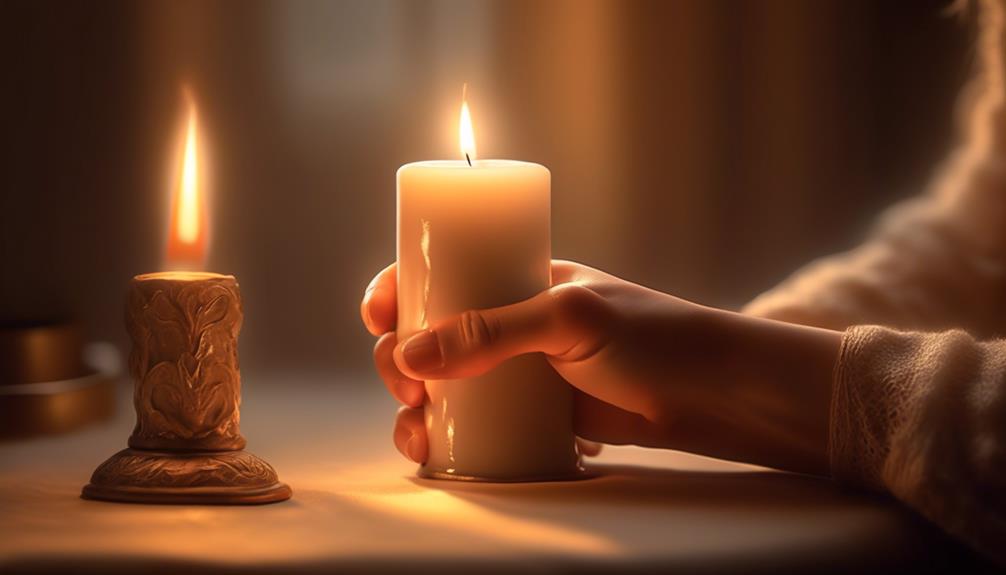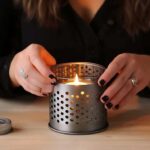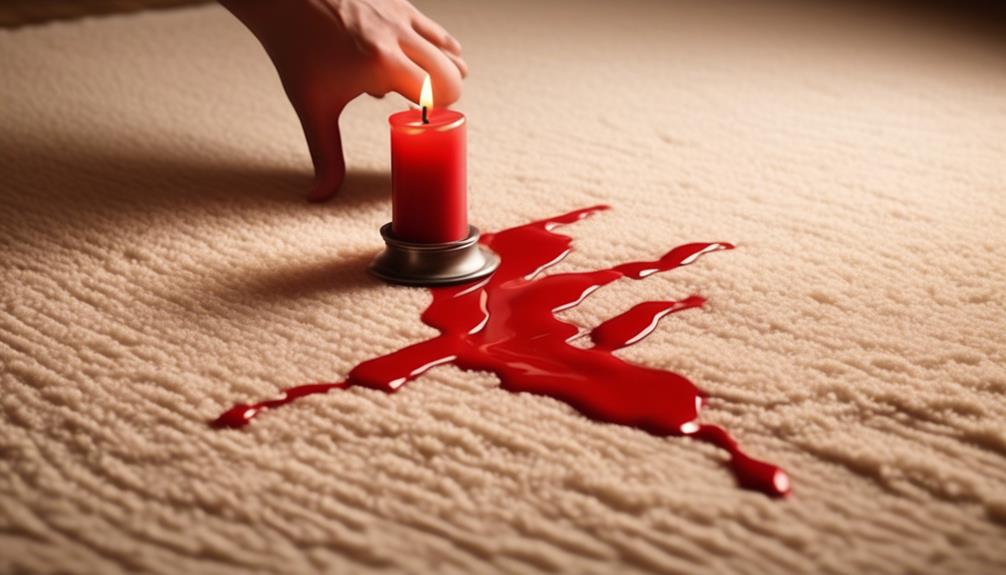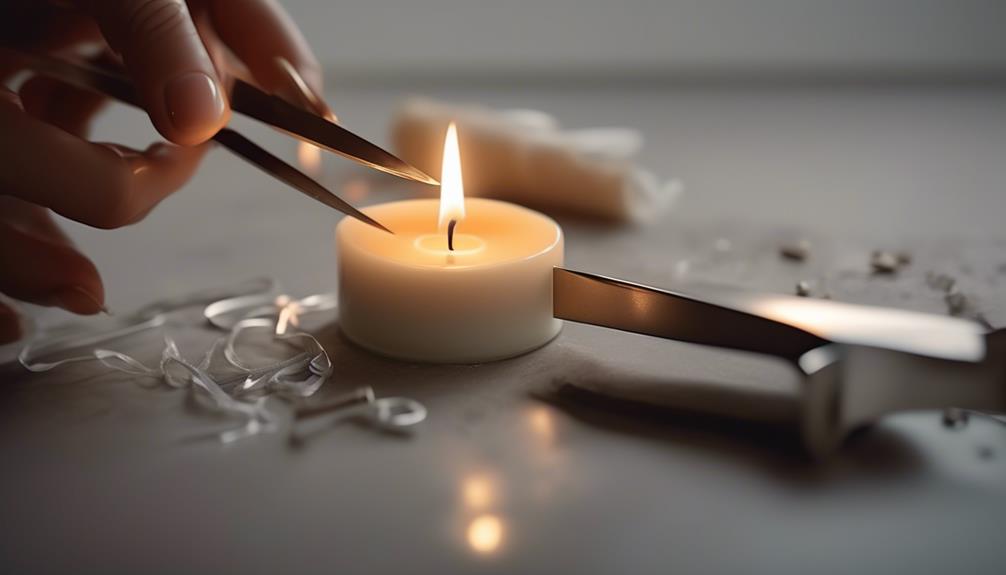When we light a small flame in honor of someone else, the words we say alongside this gesture are very meaningful. Whether offering comfort, a glimmer of hope, or a quiet request, the emotions we express hold the ability to reflect our deepest intentions.
In the quiet glow of a candle, our thoughts and wishes intertwine with the dancing shadows, creating a space for connection and reflection.
In this delicate exchange of light and words, we find a way to express our care and support for those we hold dear, encapsulating our hopes in a single, luminous gesture.
Key Takeaways
- Reflect on cherished memories and the impact the person had on your life.
- Express gratitude for their positive influence and appreciate their love and support.
- Share innermost thoughts and emotions, expressing love, admiration, and grief.
- Find comfort in the unity and support of others, embracing healing and acceptance.
Meaningful Words for Lighting a Candle
When lighting a candle for someone, it's comforting to speak words that reflect our love and memories. The flickering flame symbolizes the eternal connection we share with our loved one. As the candle radiates warmth, it also represents our grief, acknowledging the pain we carry in our hearts. In these moments of solitude, our words become a beacon of hope, illuminating the darkness of loss.
Expressing our emotions through spoken words is a powerful way to honor the memory of our loved one. We gather the courage to confront our sorrow and find solace in the shared moments we hold dear. By acknowledging our grief, we take a step towards healing and acceptance.
Heartfelt Sentiments for Candle Lighting
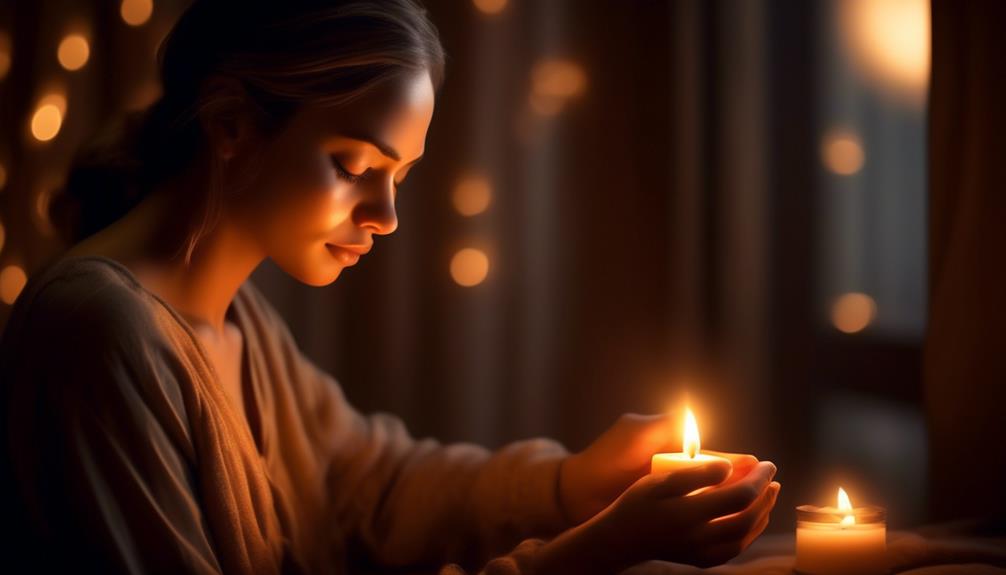
In times of remembrance, we find solace in the gentle glow of a candle as it symbolizes our enduring love and cherished memories. When we light candles during a memorial candle lighting ceremony, it's essential to express our emotions with heartfelt sentiments that truly honor the person we hold dear. Here are some ways to convey your feelings during such a solemn moment:
- Reflect on Precious Moments: Take a moment to remember the special times you shared with your loved one.
- Express Gratitude: Show appreciation for the impact they had on your life and the lives of others.
- Share Innermost Thoughts: Speak from the heart and let your emotions guide your words.
- Seek Comfort in Unity: Find solace in coming together with others who also cherish the memory of your loved one.
- Embrace Healing: Allow the light of the candle to bring a sense of peace and healing to all who gather in remembrance.
Comforting Phrases for Candle Illumination
Let us offer comforting phrases for the illumination of a candle.
When we light the candles, we do more than brighten a room; we send our thoughts and prayers to those in need.
As the flame dances, may it bring comfort and healing to their body and soul.
Let this candle be a symbol of hope and strength during their time of struggle.
With each flicker, may their spirits rise, and their burdens lighten.
As the wax melts away, may it bring peace and solace to their heart and mind.
Let the glow of this candle act as a guiding light through any darkness they face.
In the quiet moments of candlelight, may they find solace and strength to endure.
May the warm embrace of the flame remind them that they aren't alone in their journey.
Lighting this candle is our way of showing support and sending positive energy their way.
Positive Affirmations for Candle Lighting
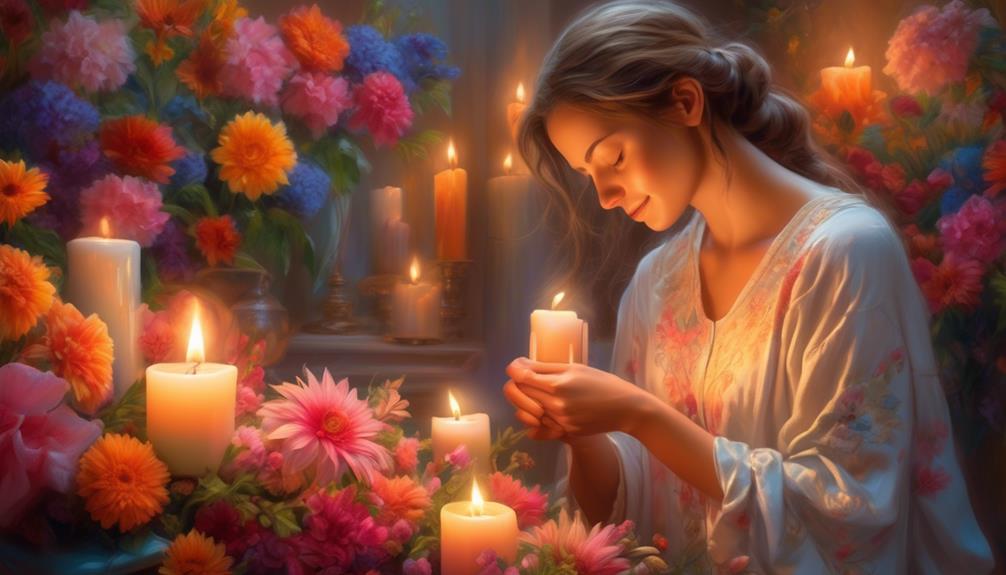
As we ignite this candle, may our intentions of healing and positivity envelop [name of person] in light and warmth. Lighting a candle isn't just about the physical act but a symbol of hope and strength that we send out into the universe for the well-being of others.
Let's infuse this moment with powerful affirmations and loving energy, knowing that our thoughts and intentions have the ability to create real change.
- Let the light of this candle remind us of the inner strength and resilience that [name of person] possesses.
- As we watch the flame flicker and dance, may it symbolize the flicker of hope and positivity in [name of person]'s life.
- With each breath we take, let's send waves of healing energy and love towards [name of person].
- This candle serves as a beacon of light guiding [name of person] through any darkness they may be facing.
- Let the warmth of this candle wrap [name of person] in a comforting embrace, reminding them that they're surrounded by love and support.
Encouraging Words When Lighting a Candle
Feeling the warmth and hope emanating from the glowing candle, we find solace in sharing encouraging words for [name of person], fostering a sense of love and support during this challenging time.
As we light this candle, let's envelop [name of person] in a cocoon of positivity and strength. May the flickering flame illuminate the path ahead, guiding [name of person] towards brighter days.
This light symbolizes hope, a beacon in the darkness, reminding [name of person] that they aren't alone in their journey. We stand united in spirit, sending our thoughts and prayers to [name of person], wrapping them in warmth and comfort.
Let the truth of our intentions be as clear as the light my candle casts, offering solace and reassurance. Together, we kindle this flame of hope, believing in the power of love and healing. Trust in the flicker of this candle, for it carries our collective energy and well-wishes.
Inspirational Messages for Candle Lighting

When lighting a candle, infuse it with heartfelt intentions and uplifting energy for the recipient. As the flame flickers, let your thoughts and prayers envelop the person in need.
Here are some inspirational messages to accompany your candle lighting:
- May this light bring you comfort and peace in your time of need.
- As this candle burns, may it symbolize the strength and hope within you.
- With each flicker of the flame, know that you're surrounded by love and support.
- Let the memories we share be the guiding light in your darkest hours.
- May this candle illuminate the path to healing and renewal for you.
In this moment of connection through light and prayer, may the warmth of the candle spark positivity and resilience within both you and the recipient. Embrace the power of this simple act, knowing that your intentions and thoughts are reaching out in a beautiful display of compassion.
Uplifting Quotes for Candle Illumination

In our heartfelt act of lighting a candle for someone, we seek to uplift and inspire through meaningful quotes that resonate with love and hope. As the flickering light of the candle symbolizes the courage to face grief, we offer these words of solace and strength.
'In the darkness, look for stars,' a reminder that even in the toughest times, there's always a glimmer of hope to be found.
'May the light of this candle be a beacon of comfort in your darkest hours,' a beacon guiding you towards peace and healing.
'Courage, dear heart,' a simple yet powerful message to instill bravery in moments of adversity.
Let this flame represent not only the memory of those we hold dear but also the resilience we carry within us.
As you light this candle, may it illuminate the path ahead, casting away shadows of doubt and illuminating the way towards brighter tomorrows.
Supportive Sayings for Lighting a Candle
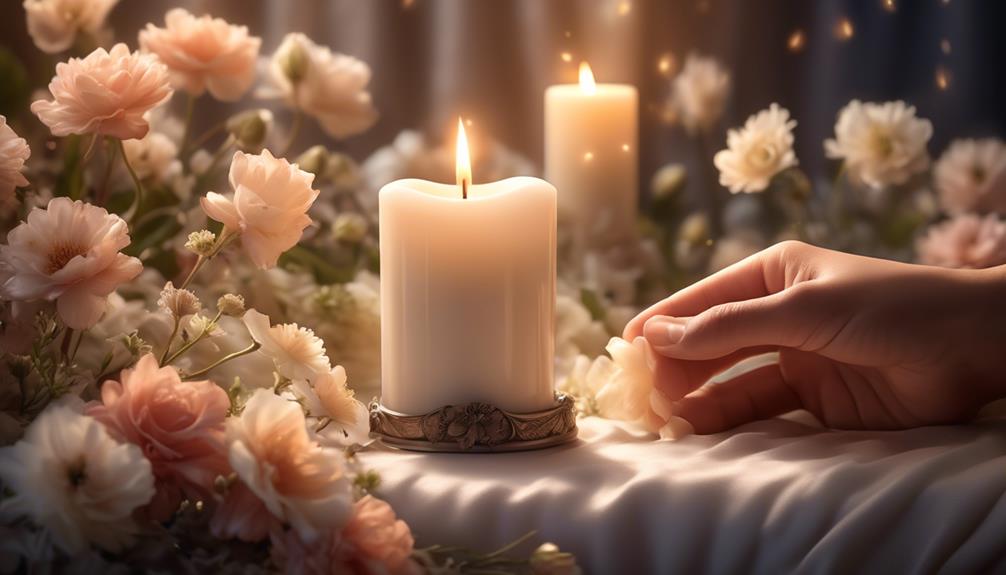
Let's explore some meaningful candle messages that can truly express our care and hope for those we love.
These supportive sayings have the power to bring warmth, healing, peace, and comfort to their hearts and souls.
In the flicker of the candle's glow, may our messages of strength and hope reach those who need it most.
Meaningful Candle Messages
With heartfelt intentions, we share comforting candle messages to uplift spirits in times of need.
- Light One: May this candle symbolize the light of hope in your darkest moments.
- Gift of Love: Sending you this candle as a token of our love and support during difficult times.
- Moment of Silence: Let's take a moment of silence together, reflecting on strength and resilience.
- Candle Prayer: May the flickering flame of this candle carry your worries away, leaving peace in its place.
- Inspirational Glow: Just as this candle burns brightly, may your spirit shine with courage and positivity.
Expressing Care and Hope
As we light a candle for someone dear, our words of care and hope become the gentle whispers that accompany the flickering flame. Expressing care and hope through a candle prayer is a powerful way to send love and healing energy to those in need. The light of love that emanates from this candle reminds us that even in the darkest times, there is always hope and strength to be found. Let us join together in sending our heartfelt intentions through this candle, offering comfort and solace to the ones we hold dear. May this simple act of lighting a candle serve as a beacon of light, guiding them through their journey with love and blessings.
| Candle Messages | |
|---|---|
| May their path be filled with love and healing | |
| This flame sends prayers of hope and strength | |
| Holding them in our hearts, we send love and blessings |
Words of Hope for Candle Lighting
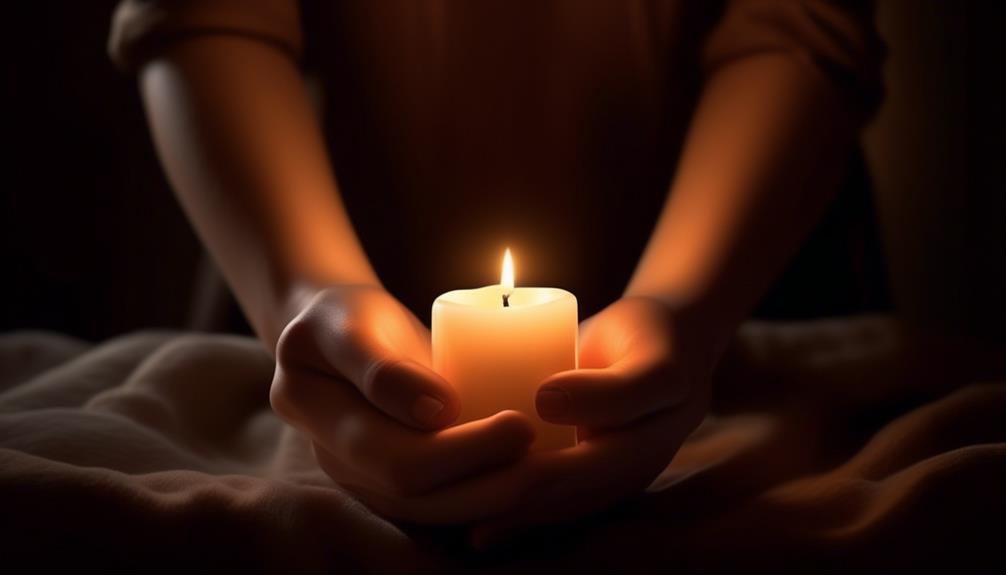
How can we infuse our words with hope and light while lighting a candle for someone dear to us? As we light the candle, let's remember the memories we shared with them, allowing the warmth of the flame to bring those moments to life.
Here are some words of hope to accompany the flickering light:
- Reflect on Strength: Think about the person's qualities and strengths that inspire you, letting those thoughts guide your words of hope.
- Share Wishes: Express your heartfelt wishes for their well-being and happiness, sending positive energy their way.
- Envision Healing: Visualize the candle's light as a symbol of healing and protection for the person you care about.
- Speak Encouragement: Use words of encouragement to uplift their spirits and bring positivity into their life.
- Pray for Guidance: End with a sincere prayer, asking for divine guidance and support to be with them always.
May these words of hope and light bring comfort and strength to both you and the person you hold dear.
Expressions of Love During Candle Illumination
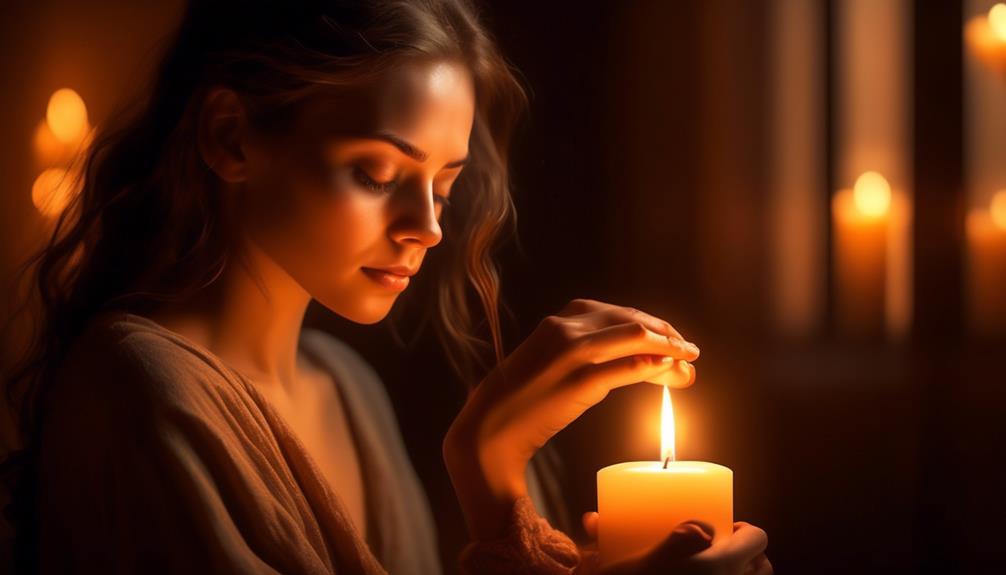
As we gather around the glow of the candle, let's share words of comfort and reminisce about the moments that warmed our hearts.
Let's infuse the flickering light with healing thoughts and surround [name] with a blanket of love.
Together, let's channel our affection and support through this simple yet powerful act of illumination.
Words of Comfort
In lighting a candle for someone dear, we express our heartfelt wishes for their comfort and peace. During this tender moment, we find solace in the flickering light and the warmth it brings to our hearts. As we illuminate the candle, let's offer words of comfort and love to surround [person's name] in a blanket of positivity. Here are some comforting words to share during this candle lighting:
- 'May this light bring you comfort in your darkest hours.'
- 'With each flicker of this candle, feel the love and warmth we send your way.'
- 'May the gentle glow of this candle be a reminder of our unwavering support for you.'
- 'In the light of this candle, find peace and strength to guide you through difficult times.'
- 'As this candle burns, know that you're cherished and never alone.'
Shared Memories
During our candle illumination, we cherish and celebrate the shared memories that bind us together in love and gratitude. These memories are like the flickering flame of the candle – they bring warmth to our hearts and light up our spirits. As we light the candle, we are reminded of the moments we have shared with our loved ones, the laughter, the tears, the joy, and the love that have woven us together. Let's take a moment to reflect on these precious memories and let them fill us with a sense of gratitude and connection. The candle serves as a symbol of the love that continues to glow between us, even in the darkest of times.
| Memories | Candle | Love |
|---|---|---|
| Shared experiences | Flicker | Connection |
| Laughter and tears | Warmth | Gratitude |
| Joy and love | Light | Bond |
Healing Thoughts
Recalling the shared memories that warm our hearts, let's now direct our healing thoughts and expressions of love towards [name of person].
As we gather in this moment of unity, let's be mindful of the power of our intentions as we light this Candle for [name of person]. Together, let's send waves of positive energy that penetrates the essence of their being, bringing comfort and solace in their time of need.
May the flickering flame serve as a beacon of hope, illuminating their path towards healing and peace. With each gentle flicker, let love and support surround [name of person], wrapping them in a blanket of warmth and reassurance.
- Let the warm glow of the Candle symbolize the love and healing we send.
- May our collective positive energy bring comfort and strength.
- Visualize healing light surrounding [name of person].
- Imagine a peaceful aura embracing them.
- Together, let's manifest healing and serenity for [name of person].
Caring Thoughts for Lighting a Candle
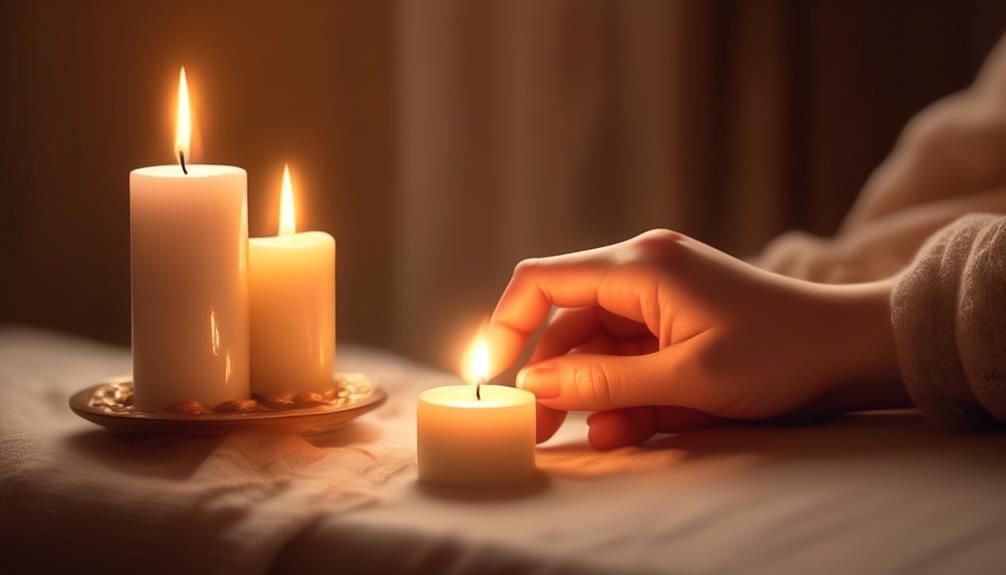
With love and care, we illuminate a candle for someone special, hoping it brings warmth and comfort to their heart. When we light a candle for a loved one, we are not just igniting a flame; we are creating a beacon of solace amidst the darkness of grief. As the flickering light dances, may it serve as a reminder of cherished memories, casting a gentle glow on the path of healing.
| Caring Thoughts | Lighting a Candle |
|---|---|
| May this candle bring warmth and comfort to [person's name]. | With love and care, we illuminate a candle for someone special. |
| As this candle shines, may it bring healing and peace to [person's name]. | May the light of this candle be a symbol of hope and strength for [person's name]. |
| With this candle, I send my thoughts and prayers to [person's name]. | – |
| – | – |
In times of grief, the simple act of lighting a candle can speak volumes of support and empathy. Let us continue to kindle these flames of remembrance, for in the gentle glow of a candle, we find a flicker of hope amidst the shadows of sorrow.
Sympathetic Words for Candle Lighting
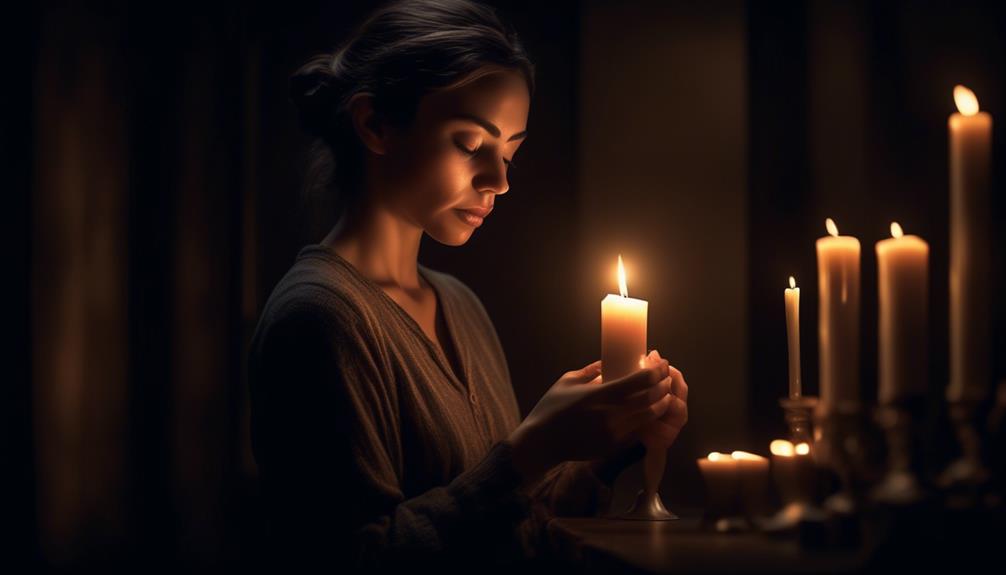
As we light a candle for someone dear, we offer our sympathy and support through these simple actions.
Reflecting on shared memories can bring solace and a sense of connection during difficult times.
Our thoughts and prayers are with [person's name], may this candle serve as a beacon of comfort and hope.
Expressing Comfort and Support
In the quiet embrace of a peaceful moment, we center ourselves and focus our thoughts on the person for whom this candle flickers. As we light a candle, it's essential to express comfort and support in a way that conveys our deepest empathy.
Here are some ways to do so:
- Offer words of solace and reassurance.
- Share memories that bring warmth and light.
- Express your unwavering support and presence.
- Send thoughts of healing and strength.
- Let the flickering flame represent hope and solidarity.
In these moments of candle lighting, our expressions of comfort and support can serve as beacons of love in the darkness.
Reflecting on Shared Memories
In our hearts, we cherish the shared memories that illuminate our paths as we light a candle for someone dear. As we take a moment to reflect on these shared memories, the warmth of the flame brings comfort and solace.
Each flicker of light holds within it the depth of our love and the essence of the bond we shared. Remembering the moments we laughed, cried, and simply enjoyed each other's company allows us to honor their legacy in a meaningful way.
Through these memories, we find strength and healing as we navigate the emotions that come with the loss of someone who's passed away.
Sending Thoughts and Prayers
Our hearts are joined in sending heartfelt thoughts and prayers through the gentle glow of this candle for [person's name], offering love and comfort in this time of need. As the flame flickers, may it bring peace and comfort to [person's name] and their loved ones.
Here are some ways we can express our support:
- Wrapping [person's name] in warmth and light
- Offering prayers for strength and solace
- Remembering cherished memories to bring solace
- Sending love and healing during this time of grief
- Hoping that this candle serves as a beacon of hope
Let us continue to uplift [person's name] with our collective thoughts and prayers, shining a light in their darkness.
Serene Phrases for Candle Illumination
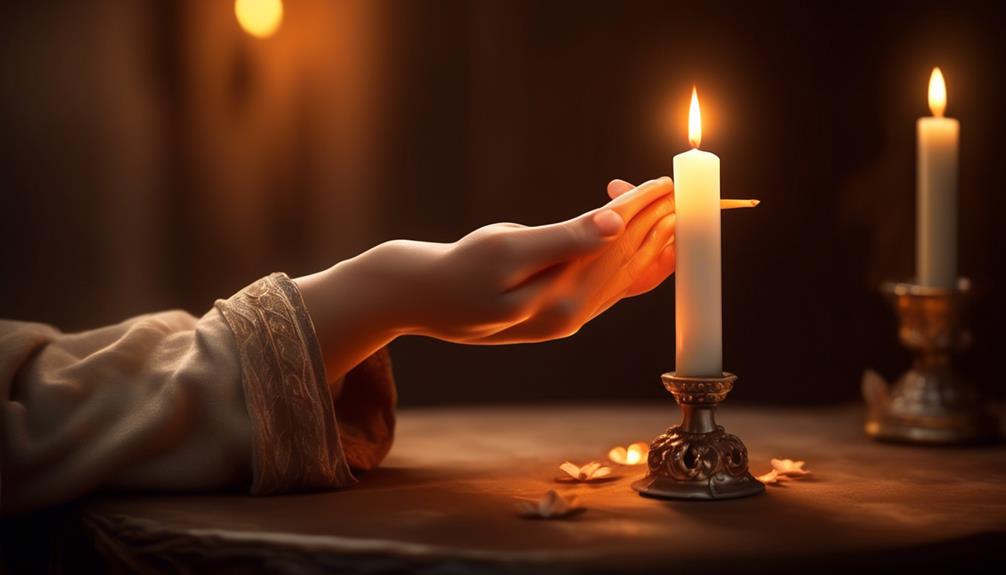
Gently whispering words of comfort and hope, we light the candle, inviting warmth and solace into our hearts. As the flame flickers and dances, we find solace in the serene glow, guiding our thoughts towards brighter days. Here are some serene phrases to contemplate as you illuminate a candle for someone special:
| Phrases | Meaning | Purpose |
|---|---|---|
| "May this light shine bright" | Wishing for positivity and hope to prevail | Bringing optimism and warmth to the moment |
| "Let this candle guide you" | Seeking to offer support and guidance | Providing a sense of comfort and direction |
| "In this light, memories dwell" | Honoring cherished moments and experiences | Invoking fond reminiscences and connection |
As we reflect on the love and positive energy we send forth, may these phrases deepen our connection to the act of candle illumination, bringing peace and serenity to both the giver and the recipient.
Peaceful Wishes When Lighting a Candle
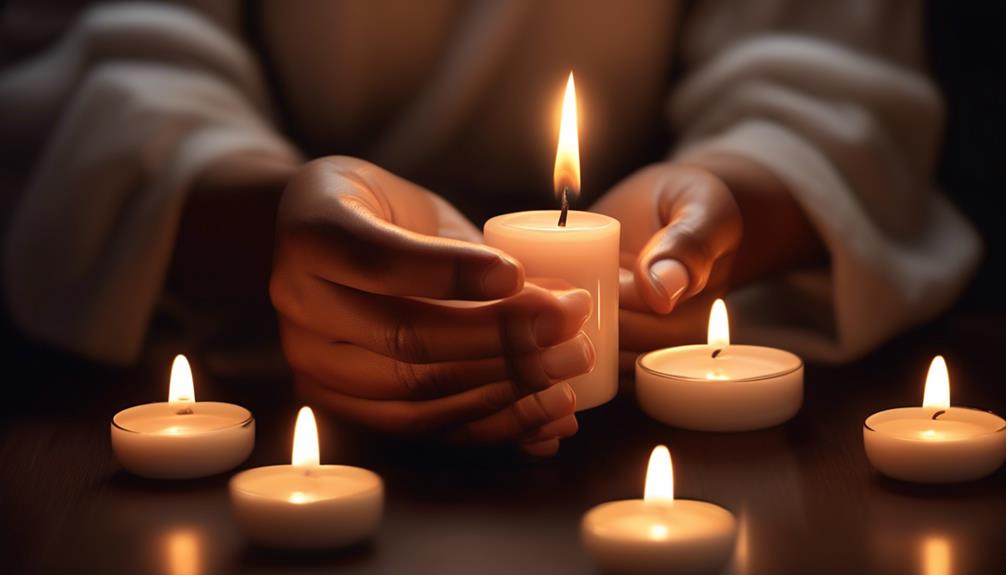
As we embrace the act of lighting a candle for someone special, our heartfelt prayers and peaceful wishes illuminate the path towards comfort and solace. In this moment of tranquility, we offer our support and love through the flickering flame that dances before us.
Here are some serene phrases to accompany your peaceful wishes when lighting a candle:
- Bless the times: May the memories of joyful moments bring solace and warmth to your heart.
- Flame will burn bright: Let the strength of this flame symbolize the resilience within you.
- Lights of love: May this candle be a beacon of love shining brightly in the darkness.
- Peaceful wishes when lighting a candle: Sending you peaceful thoughts and wishes for serenity in your heart.
- May this light guide you: May the gentle glow of this candle guide you through challenging times towards brighter days ahead.
Let the gentle glow of the candle remind you that you aren't alone, and that our thoughts and wishes are with you always.
Frequently Asked Questions
What Do You Say When You Light a Candle?
When we light a candle, we express our hopes, love, and support. It's a moment to send positive energy and comfort to those in need.
The flickering flame symbolizes hope and strength, offering prayers and solidarity. In this act, we unite in spirit, sharing light and healing thoughts.
Let's remember the power of this simple gesture and its ability to uplift and connect us in times of darkness.
What Is the Meaning of Lighting a Candle for Someone?
When we light a candle for someone, we symbolize hope, love, and support. It's a way to channel positive energy and blessings towards that person.
The flickering flame signifies healing and comfort, acting as a beacon of light in times of darkness. As the candle burns, our prayers and intentions rise to the divine, offering solace and reassurance.
It's a simple yet powerful gesture of sending warmth and positive vibes to those in need.
What Does It Mean When You Light a Candle for Someone Who Has Passed Away?
When we light a candle for someone who's passed away, it signifies our deep connection and enduring love for them. It serves as a beacon of remembrance, honoring their life and the impact they'd on us.
The flickering flame symbolizes the eternal light of their spirit in our hearts. Lighting a candle is a way to keep their memory alive and offer comfort during moments of grief and reflection.
How Do You Light a Candle in Memory of Someone?
When we light a candle in memory of someone, we create a sacred moment to honor their spirit. It's a simple yet powerful gesture that allows us to keep their memory alive.
Placing the candle safely, we carefully ignite the wick and take a moment to reflect on their life. As we watch the flame flicker, we offer our prayers and thoughts, keeping their presence close in our hearts.
Conclusion
As we light this candle together, may its flame serve as a beacon of hope and love.
Let it illuminate our hearts and minds, bringing us comfort and peace.
In the gentle flicker of the light, may we find strength and solace, knowing that we're connected in our thoughts and prayers.
Together, we stand united in support and empathy, sending our positive energy out into the world.
May this candle remind us of the power of unity and compassion.
